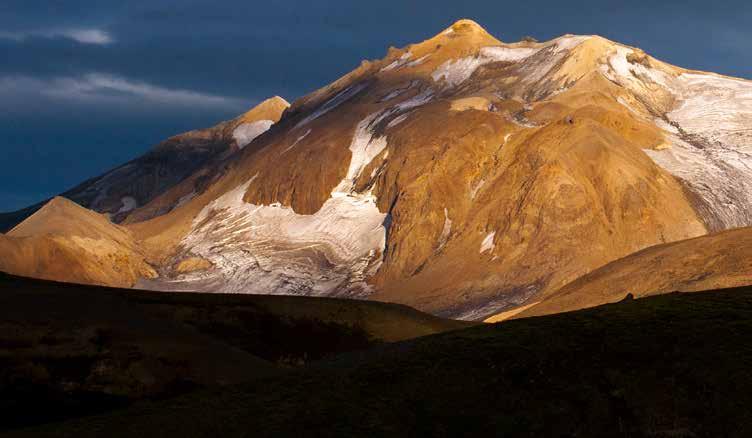
3 minute read
Survey the Scenic South
Arguably the most popular region of Iceland that never disappoints




The South is home to glaciers, volcanoes and well-known sights like Þingvellir National Park and the Geysir geothermal region (both on the popular Golden Circle tour), lesser-known gems like Þórsmörk (an area with its own micro-climate), colourful mountains, waterfalls, canyons, and lavashaped landscapes.
The classic Golden Circle Encompassing the three most visited sights in South Iceland, the Golden Circle gives you a slice of Icelandic history at Þingvellir, a spectacular view of Iceland’s bubbling geothermal activity at Geysir, and the experience of a roaring, powerful waterfall at Gullfoss. Many travellers visit Þingvellir for its geological significance, offering a rare view of the Mid-Atlantic Ridge, the meeting point of the North American and Eurasian tectonic plates. It’s also home to Þingvallavatn, the largest natural lake on the island.
The next stop on the Golden Circle route is the Geysir hot spring area. While Geysir itself currently lies dormant, its neighbour, Strokkur, erupts every seven minutes or so. Crowds gather to watch as the churning, gurgling pool of hot water erupts into a fountain of boiling water 15-20 metres high. The final stop is at the mighty Gullfoss waterfall, where the Hvítá, meaning ‘white river’, a perfect name for the turbulent white water, plunges into the deep canyon below. The falls consist of three steps, ranging from 11 to 21 metres, ending in the 70-metredeep gorge.



The scenic South Coast The south coast has a bit of everything: waterfalls, black sand beaches, charming villages and vast canyons. Two of the most popular waterfalls, Seljalandsfoss and Skógafoss, stand near the coast, and they are unmissable.
Meanwhile, a stop at Reynisdrangar provides a rare experience before heading to the quaint village of Vík. Reynisdrangar is a cluster of striking basalt sea stacks that jut out from a black sand beach. The stacks sit under the Reynisfjall mountain just outside Vík. It’s popular pastime to climb on the stacks and take photos, then roam the black-sand beach picking up stones and admiring the rock formations. Reynisfjara, from which Reynisdrangar is visible, is probably the most famous black-sand beach in Iceland. The juxtaposition of the white waves crashing on the stark black sand and pebbles is beautiful, with towering basalt columns along the shore next to a small cave.
A lesser-known attraction, Fjaðrárgljúfur canyon, is worth a visit. The canyon, which is believed to have been formed during the last ice age, has been hollowed by the Fjaðrá river, creating narrow walls. The canyon is about 2 kilometres long and about 100 metres deep and visitors can walk on a foot path along the canyon’s edge to admire the view and take photos.
The vast, striking beauty of the Vatnajökull region The South is home to yet another unmissable attraction, Jokulsárlón Glacier Lagoon. Situated in the Vatnajökull region, the lagoon features massive chunks of ice scattered about, walls of ice jut from the sea, and icebergs of various sizes float on the water. Huge blocks of ice constantly break off the Breiðamerkurjökull glacier into the lagoon which, though not very wide, is up to 250 metres deep—the deepest lake in Iceland.
Meanwhile, Svartifoss waterfall is another spectacular site. After a short hike, you can see Svartifoss (Black Falls) waterfall, where thundering white water cascades over striking black basalt rock columns.
A lesser-known gem is Vestrahorn, an area approximately a ten-minute drive away from Höfn. The shore features stunning lava dunes, that are constantly being shaped by the natural forces of water and wind. Down towards the sea, it is possible to get perfect reflections in the wet sand, a favourite for photographers.
South Iceland has something for everyone and is a must-see region. Waterfalls, glaciers, national parks and black sands await! -JG











